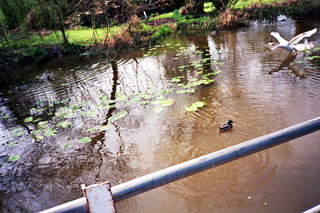Friday, January 20, 2006
Tuesday, January 17, 2006

Discovering the story within the story
Some people profess the pure and noble desire to get everything right in camera. Others of a more morally flexible nature don't feel so honour bound to commit themselves to a story carved in stone. People of such an ilk might equally not be so inclined to set themselves the challenge of achieving fifty consecutive press-ups but only one handed, of cooking a cordon bleu meal but without electricity, of generating the sound of clapping but with just the one palm. Granted getting exposure values right at the capture stage is a plus but what about when it comes to factors such as composition and perhaps more particularly, cropping?
There's nothing wrong per se in purist pursuits unless such pursuits inadvertently lead to the suffocation of something that deserves to come forth, and sometimes plain old fashioned fun alone might be sufficient justification for such deservedness.
Such simplistic seemingly antithetical standpoints aside, what camera viewfinder shows 100% of the image area anyway, and who says all stories have to be told within the confines of a 3:2 aspect ratio frame? Film makers have exploited the power of post-production editing as a means for honing story definition or indeed redefining it altogether since the inception of the cinematic form and indeed photographers have done likewise both in the darkroom and on the cutting board.
In honour of such traditions a bit of fun and a great deal of learning might be had in the practice of post capture cropping, and why not push it to the extreme while you're at it? Even if you'd rather maintain your integrity and get everything right in camera (though hopefully the subversion of your photographic value system is imminent!) some experimentation with post capture cropping might well provide you with a better understanding of the same process in camera.
Taking the opening image above as a starting point, how many different 'stories' might be contained within the same frame, how many different and varying connections might be waiting to come to the fore, how much flux might be directed and moulded in a seemingly static image?
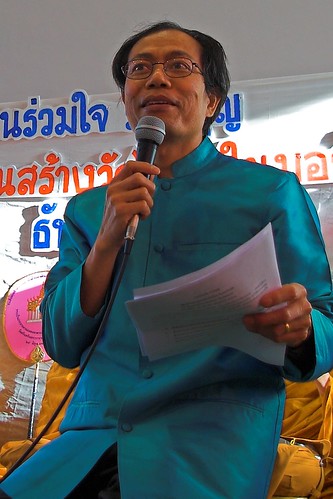


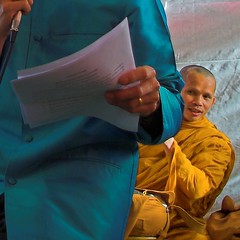

Sunday, January 15, 2006

Persistence hunting is a method that sees hunters pursuing their prey, often for hours or sometimes for days on end, until it either dies from exhaustion or becomes so weakened it is a trivial matter to catch it. 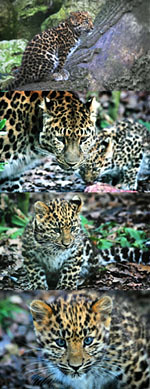 This may seem like a bizarelly single minded approach to hunting for food but amongst contemporary cultures where the approach is still practiced there is statistical evidence of its phenomenal success rate compared to other methods, and many anthropologists argue that persistence hunting played an important role in our evolutionary development as it placed us in an unparalleled position of selectivity.
This may seem like a bizarelly single minded approach to hunting for food but amongst contemporary cultures where the approach is still practiced there is statistical evidence of its phenomenal success rate compared to other methods, and many anthropologists argue that persistence hunting played an important role in our evolutionary development as it placed us in an unparalleled position of selectivity.
In a more geographically localised example of persistence, Saxton Pope in his anthropological tome Hunting With the Bow and Arrow marvels at the efforts of a native North American Indian.
"Another prominent feature of Ishi's work in the field was his indefatigable persistence. He never gave up when he knew a rabbit was in a clump of brush. Time meant nothing to him; he simply stayed until he got his game. He would watch a squirrel hole for an hour if necessary, but he always got the squirrel." What approach do you take to hunting down the goals of your photographic sustenance? Do you meander about with no fixed prey in mind seeing what you might stumble upon? Do you fling youself headlong into a herd of potential image making opportunities hoping that amidst the confusion you happen to come out with something of digestive value caught in your teeth? Or are you prepared to focus on your chosen target and pursue it for hours, for days, or if necessary for years in order to capture it?Ever since I first experienced a Mute Swan taking off from a body of water at Throop Mill in Dorset, I have known that I will go hungry until I manage to capture an image fit to encapsulate the sheer power and grace of such an occurence. I keep returning to that same location knowing that one day, surely, I must find myself in a position to close down on my photographic prey. Eventually I even invested in a lens with a longer reach to ensure I could maximise the compositional impact of the kill.
One day I was there and a swan chose the moment to take to the air.
And where was I when this happened? Over a barrier snapping away at some random doves, some rushing water, some rusted machinery, none of which were feeding any deep rooted photographic desires within me but they did give me something to chew on idly while the swans were content to just get on with their seemingly interminable rounds of bottom feeding and preening. The best I could manage was to hoist my compact rangefinder aloft and shoot over the heads of some bypassing ramblers as the swan powered past me on the other side of the barrier.
Through lack of persistence I had merely caught a glimpse of my target and stirred my hunger all the more painfully.
If we look at the contact prints for films shot by the likes of Cartier Bresson we see image after image of the same subject that is of no great significance, then some that are almost there. Then we see the singular encapsulation of the moment that becomes an image of enduring notoriety. Such images were not captured through adopting a scattergun approach to image making or through merely pottering about seeing what fate might offer us. They were captured through the persistent hunting down of a vision.
I will catch my image of a swan taking off, even if it takes me years to do so.
An example of the benefits of persistence - Leopard images courtesy of Serena M.
Further reading: The Energetic Paradox of Human Running and Hominid Evolution
Saturday, January 14, 2006
There was a time that I was so passionate about photography I forgot to seek out passions in what it was that I actually chose to point the camera at. The chosen subject that day, that minute, that second was merely a third party to the interplay between myself and my camera, a hanger on, a go between playing gooseberry in this relationship.
As a photograph is so indivisible from its subject, how can the photograph project passion when such is the condition of the photographer? Surely he should frame and display his camera instead!
I found my salvation in a box full of old family photographs resurrected through a death, a funeral and a family gathering. A plethora of poorly composed technically compromised eclectic and meandering snapshots communed with my soul and fulfilled a hollow yearning inside of me in a manner that the singular mechanistic self indulgence of my ongoing photographic approach could never hope to match.
I unleashed a passion for memory, to embrace it and capture the distilled essence of its smell, its taste and its form, a passion that has underpinned all my photography, all my snapshotography, since.
Snapshootism is not about the resultant quality of a photograph. It has at its core the nature of the relationship between photographer and subject, one in which the camera is merely a third party to that relationship. Indeed the resultant photograph might well be imbued with undeniable quality, such is what comes with experience and technical ease and poise, but most critically the snapshootist does not shrink away from that primary and virtuous relationship, that exploration of the passions linking photographer with subject, in cases where command of the mere third party, the camera, is not yet as mature as the relationship it serves to record.
Do we sometimes overlook such passions, such inherent soul, in approaching our landscape shot or capturing our macro image? Are we engaging in capturing an image of something or merely engaging in the act of photography?
Whatever type of image maker you perceive yourself as being it might be time to admit the snapshootist inside of you back into your photographic life.
Thursday, January 12, 2006
1 Emotion (51%) What do you want the audience to feel? Is it true to the emotion of the moment? All six of these criteria need to be in place for a cut to be defined as an ideal one, but the percentile weighting attributed to each of the six criteria allows for problems lower down the scale to be obscured by satisfaction of criteria higher up the scale, and for a cut to still be as near to ideal as might reasonably be hoped for. Failing to satisfy criteria higher up the scale however can rarely be masked by perfection in tackling criteria lower down the scale. Might a similar device be applied in evaluating the overall strength of a photographic image? The Rule of Five and a bit The ideal photograph is one that satisfies the following five and a bit criteria all at once: 1 Soul (51%) How the image affects the 'reader' before any analysis is applied to 'reading' the image. Does the image have a soul that speaks with the reader? Does it engage the reader emotionally? All five and a bit of these criteria are important to the definition and creation of the ideal photograph but none so important as what's at the soul of the image itself and how that soul communicates with the image's reader. Use the best available optic in the World, the most fancy camera, apply the most accurate compositional strictures before triggering the shutter and all will come to nothing if the soul was not there in the first place. What percentage of your time, attention and effort would you say you devote to the pursuit and development of each of these five and a bit criteria in your photographic work? Opening image courtesy of the author's better half.
2 Story (23%) It advances the story.
3 Rhythm (10%) It occurs at a moment that is rhythmically interesting and “right”.
4 Eye-trace (7%) Concern with location and movement of the viewer’s focus of interest within the frame.
5 2D plane of screen (5%) Planar composition.
6 3D space of action (4%) Three-dimensional continuity of actual space. Spatial relationship of subjects within scene.
2 Tone (18%) Appropriate use of tonal range and juxtaposition.
[2 plus the extra bit (in the case of colour images) Colour - appropriate combination and use of colour.]
3 2D composition (15%) Appropriate observation of compositional 'standards' such as Golden Section (eg: 'Rule of Thirds').
4 3D composition (9%) Appropriate use of depth cues within the image, defining visual anchor points for foreground, midground and background.
5 Technical qualities (7%) Appropriate precision in focus, depth of field, resolution (this can refer to clarity of optics as much as to its more modern association with digital technology), sharp capture/blurred capture of motion as 'demanded' by the context of the image, etc. etc.

Monday, January 09, 2006

In his 1974 tour de force Zen and the Art of Motorcycle Maintenance Robert M. Pirsig describes a situation in which the story's protagonist sets about repairing the slipping handlebars on a friend's brand new state of the art BMW motorcyle with a shim cut from an aluminium beer can. The solution is an ideal one as the aluminium provides material of the perfect thickness and flexibility to overcome the problem at hand and furthermore, it doesn't rust. His friend however is horrified by the notion of sullying the very essence of his crafted machine with something so base and common as a section from a beer can and settles for enduring the problem until such a time as a 'proper' repair might be undertaken.
Anyone engaged in acts of creative endeavour, photographers included, would serve themselves well in reading and absorbing Pirsig's words. Anyone engaged in photography, whatever their area of application, would serve themselves well in playing with the off-cuts of a beer can, or even a little baking foil and gaffer tape from time to time.
It's not so long since I got snagged in the spokes of the DSLR bandwagon and I've had no regrets as a result, though the odd minor irritation has been encountered. One of these revolves around the fact that for flash photography I could use the camera's pop up flash unit with harsh and ugly results, or I could spend money on a suitable hotshoe mounted flash unit with more flexibility built in. The latter was something I was not ready to invest in as I typically favour available light photography and thus the cost effectiveness of such a purchase would be limited. The former is something that caused me to miss out on shots as I felt that no shot at all was better than one mauled by direct flash or blurred beyond recognition through being captured hand held.
In essence I was behaving like Pirsig's BMW owner. Thankfully I was soon to be reawakened by Petteri Sulonen's invigorating guide to the FinnBounce. Try it. It cost nothing (based on the premise that I already had a piece of card laying about, a roll of baking foil, some glue and some gaffer tape). It really does work a treat and I am now proud to carry a hybrid FinnBounce everywhere that I take my state of the art (if somewhat budget end of the market) DSLR and I'll deploy it without embarassment in any situation where a spot of bounced flash will lift an image from the cloying shadows of murky lighting.
Meanwhile on the other side of the technological galaxy, Alan Cooper's acoustically activated strobe set up (opening image) is a marvel of budget innovation and good old audio visual wit. The set up illustrated in the photograph cost Alan approximately UK Pounds Sterling 99.40 (roughly double the figure to calculate the US$ equivalent) but he assures me that exactly the same results can be achieved with less expensive components totalling UKP 38.40 or even UKP 28.40 if one were to forego the microphone stand. The UKP 0.40 was for the bottle of milk which Alan tends to water down to spread out the ongoing running costs of his scientific art. Treat yourself to a view of his results here and here. Okay, so it's not Harold Edgerton's bullet piercing an apple (not least since Alan's work contains a great deal more in the way of calcium) but that's not the point.
Whatever you decide to do with your photography, let your hair down, loosen that knot in your tie and if you don't have immediate access to Alan's more exotic components be prepared to shoot with accessories that look like they were pieced together by a child in kindergarten art class (my hybrid version of the FinnBounce being the case in point). Have you ever had so much creative fun as you did back then?

Sunday, January 08, 2006
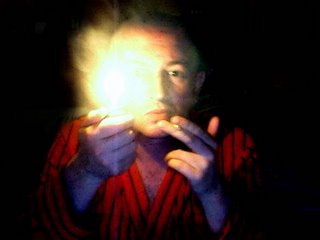
Prolink DS3303U
Modestly proffering a maximum resolution of 640 x 480 pixels the Prolink DS3303U might not quite match up to the likes of the Canon 1DS Mark II in terms of megapixels (or more strictly speaking kilopixels) but coming in at around the same weight as the Canon's remote switch, the Prolink does have the advantage of lightness and mobility.
Or that might be the case were it not for the limitations brought about by the use of the USB cable required to power the camera from a computer, and to feed images from the camera back to that computer.
Tethered operation of DSLRs in the studio is quite popular amongst professionals however thus hopes that the Prolink could come into its own in studio based situations might not be hollow ones. Indeed the opening image here might indicate the potential for such tethered studio use.
The lack of onboard image storage capabilities (with such a diminutive unit even the space for a secure digital card is lacking) might put off sports and landscape photographers but tethered to a laptop the Prolink could still make for the perfect solution for those with budgets to consider, or uncomfortable with wielding hefty pro-body Canons, Nikons and their ilk.
Whilst image softness might be an issue for some discerning photographers you might always try removing the fixed focal length lens of the Prolink with a hacksaw and replacing it with, perhaps, a MM series Contax lens attached with an ample turn of gaffer tape.

Saturday, January 07, 2006

In 1995 Lars von Trier, Thomas Vinterberg, Kristian Levring, and Soren Kragh-Jacobsen established the Dogme 95 collective in Copenhagen with the avowed aim of rescuing film, nay ressurecting it from a death inadvertently brought about through the success of new wave cinema and the resultant corruption of that particular revolution. This ressurection would come about through the determined application of The Vow of Chastity, a set of 10 rules established to inject film with a heroic dosage of honesty.
The Idiots (1998) and Gummo (1997) are amongst my favourite examples of the genre, the latter being more informed by the guidelines of Dogme than ruled by them. In fact Gummo is an important case in point, as it is not strictly speaking a Dogme film. Or is it not?
Between 1992 and 1997 (dependent upon interpretation of the lore) a small group of Austrian students (or canny businessmen, dependent upon interpretation of the lore) established the Lomographic Society International with the explicit (and possibly retrospective) aim of studying and documenting the world's surface (not literally the soil, though that also might be included) by taking millions of snapshots of it. The LSI established a set of 10 (golden!) rules of Lomography to help guide its ever growing army of followers on this grand mission.
Mireille Schoone and noitheboy are amongst my favourite exponents of 'Lomography' and the opening image here is one of my favourite personal examples though having been captured with something other than a LSI sanctioned camera it is not strictly a 'Lomograph'. Or is it not?
Between several thousand years ago and somewhat more recently a disparate lineage of philosophers, practicing philanthropists and outright crackpots have established, inadvertently or otherwise, a range of theological schools that have vied for our attention and loyalty. Each of these schools brings with it a set of rules and in at least one major case a specific set of 10 rules (though apparently that started out at 20 and was reduced either for simplicity's sake or due to the outcome of a fit of pique, dependent upon interpretation of the lore).
Amongst my favourite exponents of such systems are just about anyone that uses whichever system's various 'rules' as a general and adaptable guide to the best way to approach situations in life rather than acting slavishly upon the fossilised texts of philosophers (etc.) whom in the first instance might more likely have been aiming to establish a set of broad psychological toolsets for dealing with the rigours of life, some philosophical balls to kick about and bounce off walls, rather than an ossified set of strictures. I've never killed (a human) yet I'm not a Christian. Or am I not?

Friday, January 06, 2006

I recently cancelled the direct debit mandate that paid, on a quarterly basis, for my subscription to Amateur Photographer magazine. My cancellation stemmed from a minor fit of pique at the magazine's treatment of the 2005 Schweppes Photographic Portrait Prize.
In an article entitled In need of a grin and tonic (he's as much of a wit with wordplay as I) Bob Aylott states that the work turned in by the SPPP winner and runners up was "dated and the stuff of clueless first-year art students". Despite the fact that I found the top ranked entries thought provoking and challenging in the most positive sense of those terms, my ire was in no way piqued by this statement of Ayllott's. I've said as much of the later films of David Lynch in the full knowledge that some might be offended.
What I did find offensive however was the journmalistic imbalance inherent in a piece where a couple of supposed doyens of the photographic establishment were wheeled out to pour scorn on the nature of the competition and the efforts of its winning entrants without any effort being made to secure an alternative point of view from the SPPP organisers or entrants themselves. Even this wasn't sufficent however to get me on the 'phone to my bank to cancel my payments.
In concluding the article Aylott invited readers to "Send us your pictures - If you have a picture that you think deserves to be a Schweppes winner, we would love to see it" backed up by a threat to publish a selection at a future date.
In the face of this concluding request I couldn't help but envisage an admitedly feeble echo of the worst excesses of the tabloid media and my mind was flooded with images of an angry mob of torch wielding chocolate box photographers backed up by a militia of optical techno fetishists and 'perfection' masochists marching upon the aesthetic Sodom and Gomorrah of image making debauchery that is the Schweppes Photographic Portrait Prize.
Once they're finished with this minor titilation parading as a campaign for what is right and good in photography, Bob Aylott and AP might like to turn their attentions to dealing with the cult know as Lomography. I couldn't help but think of this latter broad 'school' of aesthetic approach to photography as the SPPP entries suggested to me notions of 'this is what Lomographers would do when they turn pro' and Aylott's manner of attack on the SPPP is nothing less than a broad and heavy handed dismissal of all manner of aesthetic approaches to photography that don't fit what I presume must be his ideal.
There's little one can't pick up on the Web these days in the way of aesthetic inspiration or examination of technical process so I shan't feel that great a loss at no longer receiving AP on my doormat every Saturday morning. I am however still a great fan of the printed form so I've switched my pennies to a subscription for National Geographic magazine.
Now if I can't learn something about photography from that publication I shouldn't have been bothering with the photographic press in the first place.
Opening image copyright of Steve Harper.


Why do we take photos of certain subjects time and again? I hit upon this question in relation to a plethora of images of ducks that I've taken in recent months. I often visit an area of countryside bordering the outskirts of my town called Throop and there are indeed ducks aplenty to be found there.
Now there's something that leaves me empty when looking at all of those duck shots, and it's not the fact that many are brazenly appaling and the rest have an abundance of deficiencies in terms of composition or exposure or both and probably more. When I reflected upon things honestly, I realised that I'm simply not fascinated by ducks, certainly not as a photographic subject. I think ducks are cool by the way, frankly I think they rock, but I'm just not interested in them as a photographic subject. Swans are another matter, but in the case of these particular birds all that genuinely fascinates me is capturing the sheer energy and power of one taking off from the river and for the time being I'm stuck with a multitude of shots of preening and bottom feeding Mutes.
So why do I keep photographing ducks on my jaunts to Throop? It's simply because they are there and I use them to engage in some form of photographic calisthenics with no spiritual aim, if that's not labouring potential motivation far too much, but just to practice technical execution.
Now there isn't necessarily anything wrong in practice, but perhaps practice isn't just about applied physical technique alone. Also, there's the notion of killing two birds with one stone and actually practicing with things that do get us excited somewhere deep inside.
Now the real reason I visit Throop so much is that I love the river. Water is a great source of tranquility after all. This is why regardless of any lingering technical deficiencies I really like the shot above. The ducks are essential in my view to balancing the image but really they serve as a counterpoint to the real subject and it's that real subject that I do feel a desire to capture the spirit of in photographs.
Thus my New Year's Resolution is to stop shooting ducks and to start shooting the water that surrounds and carries them.
Which is, of course, a metaphor.


